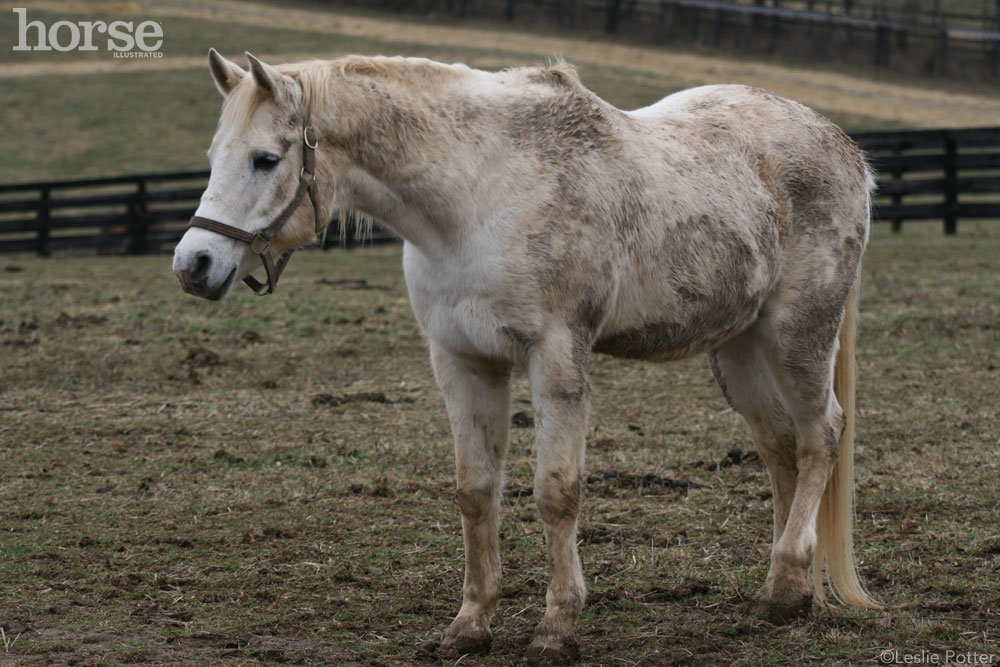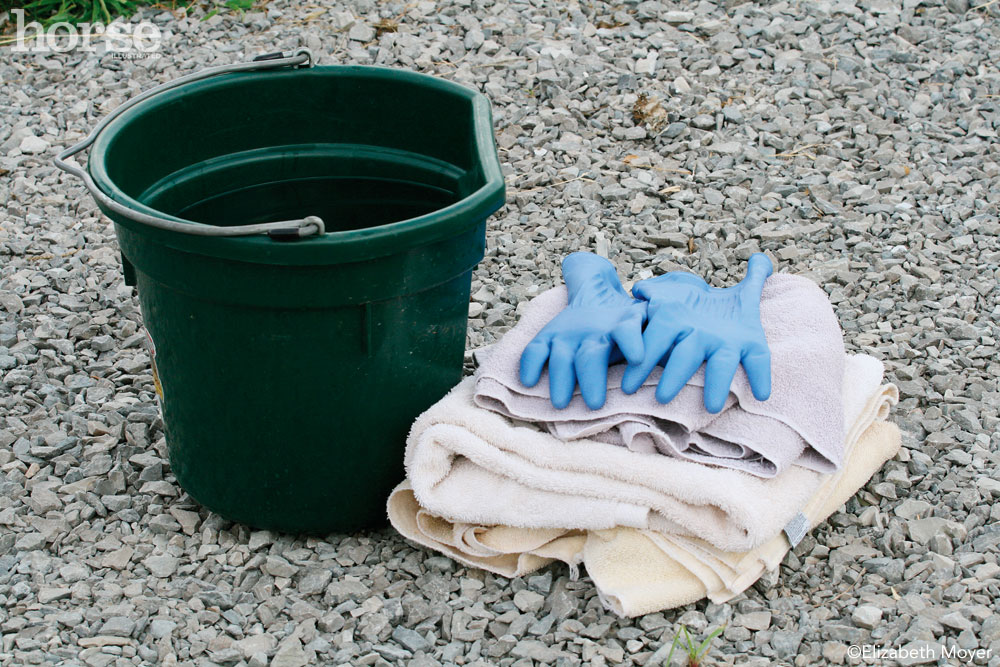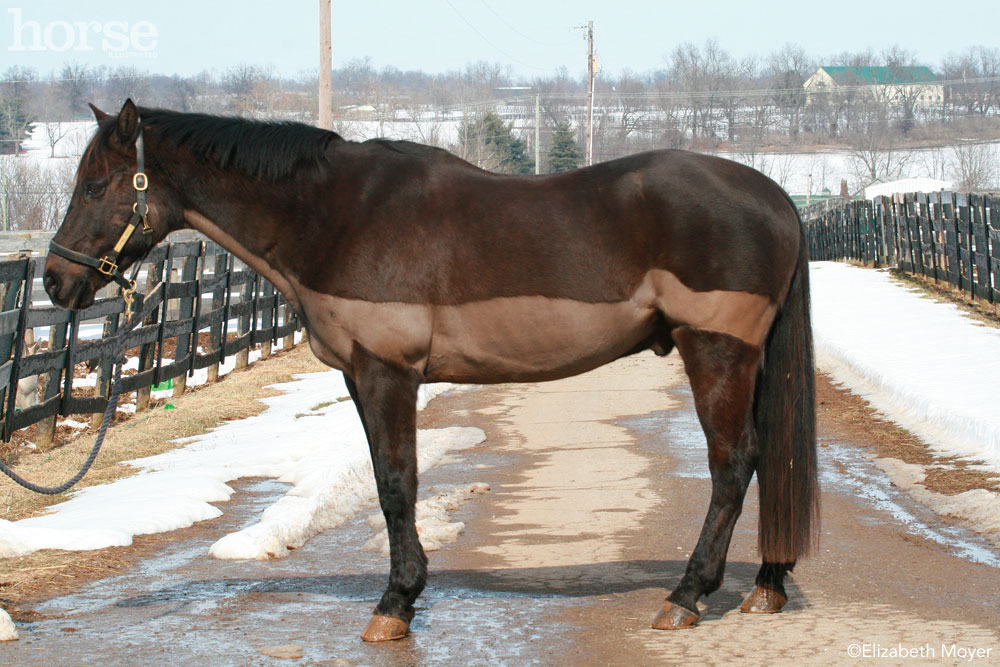
Mud is part of a horse owner’s reality, but keep it in control to avoid equine skin problems.
Problem: Mud
Horses are a magnet for mud. They love to wallow and roll in it. The easiest way to manage mud is to hose it off. However, in the dead of winter, that’s usually not possible. If it’s too cold to give your horse a rinse, you have a few options.
The first strategy is to let the mud dry, and then brush off as much as you can. If your horse will tolerate it, you can gently scrape the biggest chunks off his body with a metal curry or shedding blade. For more sensitive types, use a pebbled rubber grooming mitt or rubber curry. The grooming mitt works well on the legs and head. Follow up with a stiff or medium brush. Be prepared: this process requires plenty of elbow grease and will generate a cloud of dust to rival Pig Pen.
Never brush wet mud; this will only grind it in deeper into the coat. A better option is to use a damp towel to remove as much of the mud as possible. However, the best offense is a good defense. Prevent a winter mudfest by dressing your horse in a blanket that’s an appropriate weight for the weather. Adding coat polish spray to your regular grooming routine a few times a week will help repel stains and keep mud from sticking to your horse’s coat; just take care to avoid the saddle area.
Bathing Your Horse in Cold Weather
When it’s too cold to bathe your horse, you can still accomplish quite a bit of cleaning with a bucket of water and a few towels.
Supplies:
- 5 gallon bucket
- Several old towels. A bath-size towel cut in half is a little more manageable size to work with.
- Rubber kitchen gloves
- Fleece or wool cooler
- Coat polish spray

When your horse needs a more thorough cleaning in cold weather, a bucket bath is the solution.
Fill the bucket with hot water if it’s available. Dunk a towel in the water and wring it out thoroughly. You may want to wear rubber gloves to protect your hands. Ideally the water should be as hot as is safe for you and your horse. Remember that the towel will start cooling down rapidly. (You can use cold water too if that’s your only option.)
Working in small sections, towel your horse vigorously, going back and forth against the hair growth to lift dirt. Follow with a dry towel in the same manner to remove excess moisture. Don’t be afraid to go against the direction of hair growth; this will allow you to get a deeper clean. Leaving the hair fluffed up helps to speed the drying process.
If it’s very cold out, cover your horse with the cooler and just expose the part of the horse you are working on. You should be OK to wash your horse’s legs and tail with the hose unless the weather is extreme.
Change the water as needed (it will get dirty quickly), and replace your towel if it gets too dirty.
To finish, spritz with a conditioning coat polish spray to give your horse’s coat an extra touch of shine and to help repel dirt and mud. Cover him with the cooler to keep him from getting chilled. The cooler wicks moisture from the coat to help it dry faster as well.
Problem: The Wet, Woolly Mammoth
Your horse has sprouted the coat of a yak, and now he’s managed to work up a sweat. How do you deal? You need to cool him out and dry him off before putting him away. When it’s soaked down, that thick winter coat loses its insulating properties and your horse could become chilled.
Here’s one way to do the job: You’ll need several old bath towels and a cooler or sheet in a moisture wicking material such as fleece or wool. It helps to have an extra cooler on hand if the first one becomes soggy. After you untack, cover your horse with the cooler. Pull back the cooler to access one area at a time and give your horse a vigorous rubdown with your towel to remove as much moisture from the coat as possible. Rub against the direction of growth to fluff the hair up and help it dry. Change towels if the one you’re using gets too wet or dirty. In addition to keeping your horse warm, the cooler will also wick moisture from the coat. Your horse should be mostly dry before you put his blanket back on. If he is still slightly damp, a fleece blanket liner or layer of straw bedding under his blanket will help absorb the remaining moisture.
Problem: Sweat Marks
Even a light ride can leave a few sweat marks behind under the saddle and bridle. To remove sweat marks from a winter coat when it’s too cold to hose or sponge off, try this easy method.
Tools: curry comb, hard brush, medium brush, spray bottle of water, isopropyl alcohol, towel.
- Step 1: Curry in circular motion with strong pressure (be gentle on face).
- Step 2: Use hard brush to whisk away loose dirt (use medium brush on face).
- Step 3: Spray large areas with water spray bottle (use damp towel around face). Use as little water as possible if it’s cold. To speed evaporation, add a little isopropyl rubbing alcohol to water.
- Step 4: Use towel or hard brush all over horse’s body to lift moisture out of coat.
- Step 5: Work the hard brush straight down. Helps hair dry without “tiger stripes.” If time permits, give another brushing after the coat is dry.
Problem: Static Electricity
The snap, crackle pop of static electricity is common due to dry winter air, and it’s an unwelcome shock when brushing your horse or removing his blanket. The key to counteract static is moisture. Spritz your horse’s coat with a conditioning spray to help zap static. Or, spray your brush periodically as you groom. Shine and detangling sprays also have the same helpful effect. A lightly dampened brush or rag is another simple way to counteract static during grooming, with the added bonus of removing surface dust. To avoid creating more static charge, lift your horse’s blanket off rather than pulling it across his coat. Many horse people also swear by static guard spray on their blankets.
Problem: To Clip or Not to Clip?
If you have an active winter riding schedule or live in a warm winter climate such as California or Florida, body clipping is the ultimate winter grooming solution. Using large, powerful clippers to zip off that winter coat will allow your horse to sweat less, dry quickly and be more comfortable when exercising. However, a clipped horse can be high maintenance. If you opt to body clip, you’ll need to commit to keeping your horse blanketed appropriately for the weather. This is a daily chore that can’t be skipped, and you’ll need to keep a close eye on the forecast. You’ll need a full blanket wardrobe from lightweight to heavyweight, and possibly additional hoods and liners as well. A full-body clip is recommended only for horses that are stabled full or part time.

A horse with a trace clip.
If you live in a cold-weather climate and need to clip but also want to leave your horse with some natural protection, you might opt for a partial clip instead. You’ll still have to blanket, but it’s a little less extreme. A trace clip removes hair only from the underside of the neck, chest, belly and flanks where horses tend to sweat the most. The legs, back and topline still sport a full haircoat. The more minimal strip clip removes hair from the underside of the neck and part of the chest.
Body clipping takes some practice to master. It’s best to learn from an experienced clipper, but it’s really not hard to do. The key is good preparation with a clean horse, clippers that are heavy-duty enough for the task, and freshly sharpened blades, along with a spare set.
Armed with these winter-busting tips, no grooming challenge will keep you from enjoying your horse once the weather turns frosty.
This article originally appeared in the November 2015 issue of Horse Illustrated magazine. Click here to subscribe!







Why do people feel they have to clip their horses durning the winter?, horses would rather be warm clean stall and food then look pretty if they could talk that is what they would say.